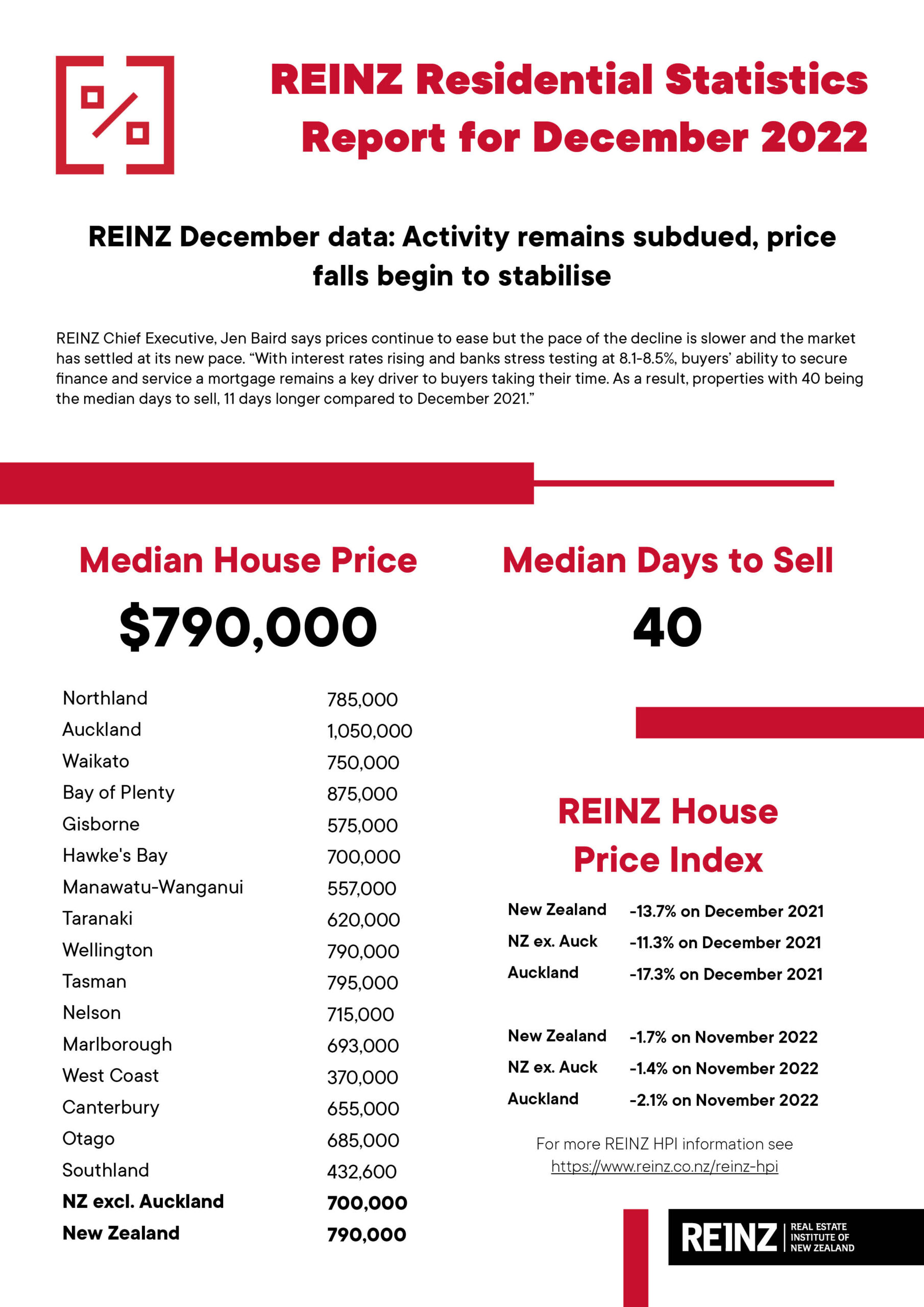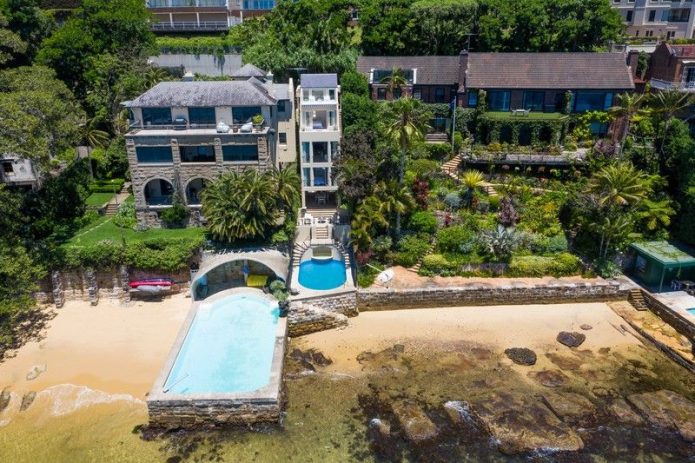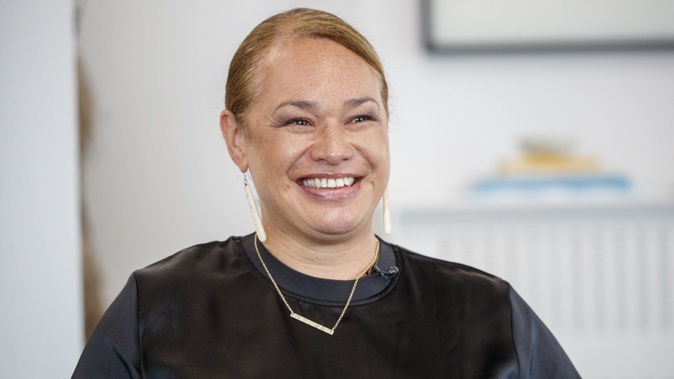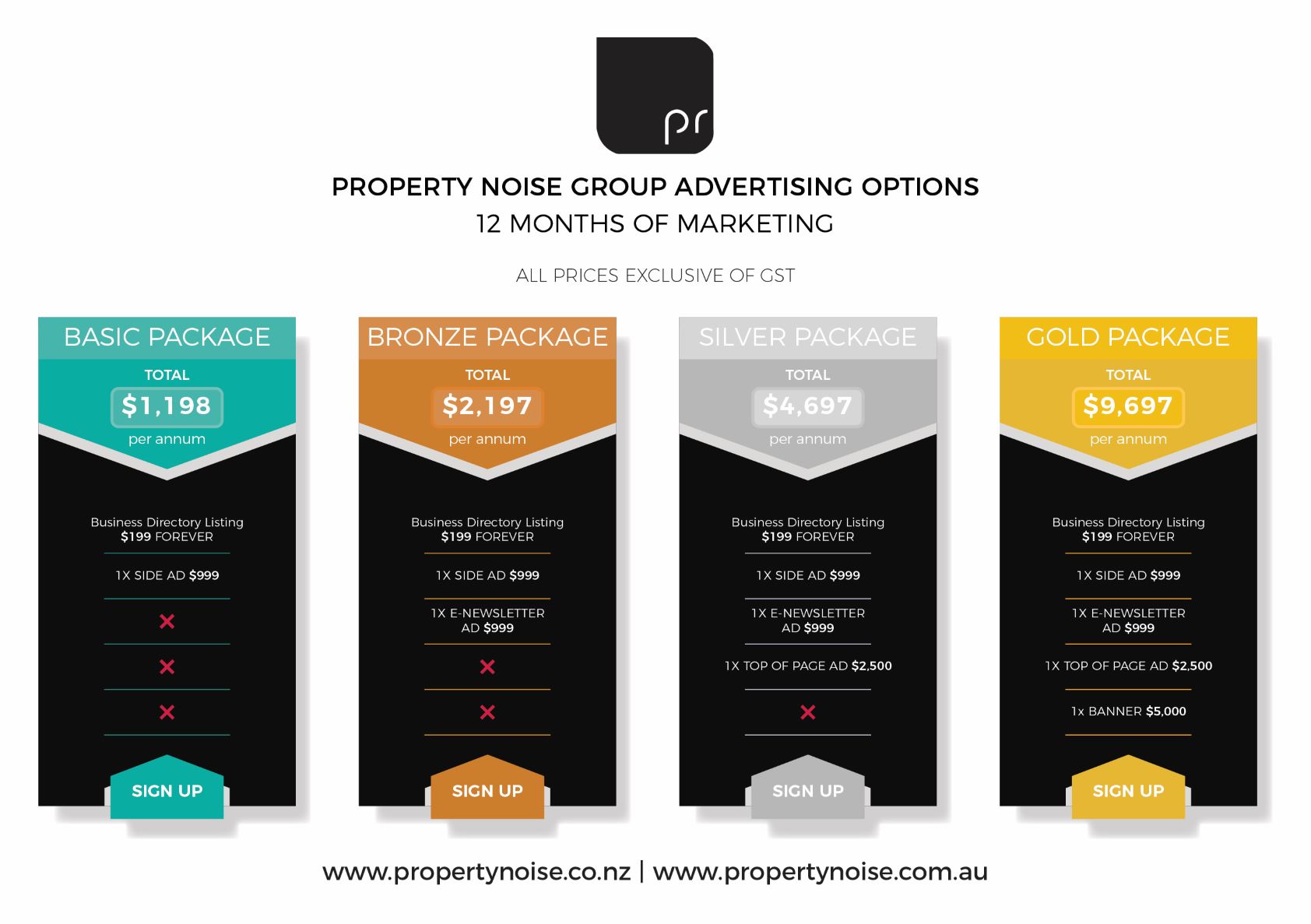PHOTO: REINZ Chief Executive, Jen Baird
REINZ December data: Activity remains subdued, price falls begin to stabilise
The Real Estate Institute of New Zealand’s (REINZ) December 2022 figures show house prices are still declining, with properties taking longer to sell across New Zealand.
2023 PRICING: Profile YOU on this website! – FOR 12 MONTHS | ONLY $999 plus GST
REINZ Chief Executive, Jen Baird says prices continue to ease but the pace of the decline is slower, and the market has settled at its new pace.
“We usually see a slowing of activity as we head into the festive season, and we are comparing this December to one that was right at the peak of the pandemic market.
“Buyer caution is evident in the drop in count of sales, down 23.6% month-on-month and down 39.0% annually from December 2021. Comparing this activity to the long-term trend, we can see the current market is weaker than this trend. This is leaving a lot of choice for buyers with a 55.3% increase in inventory – now sitting at 26,057 properties.

“With interest rates rising and banks stress testing at 8.1-8.5%, buyers’ ability to secure finance and service a mortgage remains a key driver to buyers taking their time. As a result, properties are spending longer on the market with 40 being the median days to sell, 11 days longer compared to December 2021.”
“The median sale price has decreased nationally by 12.2% overall to $790,000 and decreased 7.9% for New Zealand excluding Auckland to $700,000. The REINZ House Price Index (HPI) showed an annual decrease of 13.7% in the value of residential property nationwide which is in line with the sale price changes we are seeing,”
“Again, cheaper prices coupled with more choice for buyers means sellers have to be realistic about their price and timing expectations.”
Regional median house prices have decreased across the board except for Northland which saw an increase of 3.3% and Taranaki 5.1%. These were the only regions to see a rise in median price compared to December last year.”
Wellington is now into its 14th consecutive month of being in the bottom two ranked regions for the year-on-year House Price Index movements.
“Salespeople around the country say sellers are tending to be more realistic and will usually meet the market through negotiation – although it’s taking longer to sell, sellers are still getting results.”
Baird suggests that for some buyers, now is a great time to be in the market.
“If you can make the finances work, this is a good time to be a buyer. More stock, less competition and prices continuing to ease, will allow those who can get all the ducks in a row to buy well.”
The Real Estate Institute of New Zealand (REINZ) has the latest and most accurate real estate data in New Zealand.
Fact sheet
National highlights
- December data shows median prices falls and days to sell have stabilised.
- The number of residential property sales across New Zealand decreased month on month by 23.6% also decreasing 39.0% compared to December 2021.
- Nationally, the median price for residential property decreased 12.2% annually to $790,000 and decreased 7.9% for New Zealand excluding Auckland to $700,000.
- The median number of days to sell a property in December was 40 —11 days longer than in December 2021, 1 day less than November 2022.
- The REINZ House Price Index (HPI) for New Zealand showed an annual decrease of 13.7% in the value of residential property nationwide.
- At the end of December 26,057 properties were available for sale across New Zealand — an annual increase in inventory of 55.3%.
Regional highlights
- Wellington, Auckland, Gisborne, and Tasman had the largest drop in median sale price with –20.2%, -18.0%, -17.3%, and -14.1% respectively.
- Northland and Taranaki were the only two regions seeing an increase in median sale price, up 3.3% and 5.1% respectively.
- Median sales prices in the regions for December (year-on-year) have dropped overall (except Northland and Taranaki):
- Northland: median price increased 3.3% to $785,000
- Auckland: median price decreased by 18.0% to $1,050,000
- Waikato: median price decreased by 11.7% to $750,000
- Bay of Plenty: median price decreased 5.1% to $875,000
- Gisborne: median price decreased 17.3% to $575,000
- Hawke’s Bay: median price decrease 13.8% to $700,000
- Taranaki: median price increased 5.1% to $620,000
- Manawatu/Whanganui: median price decreased 13.9% to $557,000
- Wellington: median price decreased 20.2% to $790,000
- Nelson/Marlborough/Tasman: median prices in the Nelson, Marlborough and Tasman regions decreased by 11.7%, 1.0% and 14.1% to $715,000, $693,000, and $795,000 respectively
- West Coast: median price was static (0.0%) at 370,000
- Canterbury: median price decreased 3.7% to $655,000
- Otago: median price decreased 5.0% to $685,000
- Southland: median price decreased 4.9% to $432,600.
More information on activity by region can be found in the regional commentaries section of the Monthly Property Report.
Median house prices
Our two biggest cities have seen ongoing declines in year-on-year median prices over the course of 2022.

With Auckland, all seven Territorial Authorities (TAs) had negative year-on-year median price movements with Papakura the largest fall at -23.6% from $1,010,000 to $772,000, followed by Waitakere City at -20.5% from $1,170,000 to $930,000. The region has recorded eight consecutive months of year-on-year median price decreases for the first time since June 2008 – January 2009.
In Wellington, seven of the eight TA’s had negative year-on-year median price movements with Upper Hutt City largest fall at -24.5% from $920,000 to $695,000, followed by Wellington City at -24.2% from $1,161,000 to $880,000. At a regional level, this is the first time since records began that this region recorded seven consecutive months of year-on-year median price decreases.
Sales counts
If we exclude the month of January (usually the lowest month for sales count) and the two Level 4 lockdown-affected months of April 2020 and May 2020, December 2022 had the lowest sales count in:
- Northland since October 2011
-
- New Zealand excluding Auckland since February 2011
- Taranaki and Waikato since December 2010
- New Zealand since October 2010,
- Auckland since December 2008,
- Wellington since June 2008,
- Nelson since records began
In addition to the above, in terms of the month of December, this December saw the lowest sales count in:
-
- Gisborne and Nelson since records began
- New Zealand excluding Auckland, Hawke’s Bay, Marlborough, and Wellington since 1995
- Otago since 1997
- Auckland since 2008
- Bay of Plenty, Canterbury, Northland, Taranaki, Tasman, and Waikato since 2010
All regions’ sales counts dropped since December 2021 and all the regions had a decrease on November 2022.
Days to Sell
Ten out of fifteen regions had an increase in median days to sell compared to November 2022, and all the fifteen regions had an increase in median Days to Sell compared to December 2021.
For New Zealand, Hawke’s Bay, Manawatu/Whanganui, and Northland this month was the lowest days to sell since April 2022 (8 months)
In terms of the month of December, the last time the median days to sell was higher in
-
- Waikato was in 2000
- Auckland was in 2001
- New Zealand, Nelson, Otago, and Wellington was in 2008
- New Zealand excluding Auckland, and Tasman was in 2010
- Gisborne was in 2011
- Bay of Plenty, Manawatu-Whanganui, and Marlborough was in 2013
- Hawke’s Bay and Southland was in 2014
- Taranaki was in 2017
- Canterbury and West Coast was in 2018
- Northland was in 2019
Inventory
Twelve of the fifteen measured regions (80%) had at least a 60% YOY increase in inventory
Listings
Nationally, new residential property listings have decreased 25.9% year-on year.
Regionally, all but two regions (Gisborne and Taranaki) have had a decrease in listings since December 2021.
Over half of the regions have had listings decrease by more than 20% year on year.

Auctions
Nationally, 11.7% (509) of properties were sold at auction in December 2022, compared to 30.4% (2,162) in December 2021. New Zealand excluding Auckland saw 8.7% of properties (262) sell by auction compared to 21.7% (1,018) the year prior. Gisborne and Canterbury had the highest percentage of sales by auction for December 2022 with 50.0% and 18.9% respectively.
Inventory and listing data come from realestate.co.nz.
More information on activity by region can be found in the regional commentaries section of the Monthly Property Report.
ENDS
MOST POPULAR
- Property investor charged with fraudulently obtaining millions of dollars in home loans
- Lisa Marie Presley dead at 54 – How did she lose all the Elvis millions? | WATCH
- Housing market could stall as New Zealand enters an election year
- ‘It was no palace’: Prince Harry admits he was ‘EMBARRASSED’ to show Meghan Markle his Nottingham Cottage home | WATCH
- Claims about Jacinda Ardern’s wealth
- Grand Designs NZ: Off-grid Taylors Mistake house still not finished
- Australia’s most expensive streets revealed
- Abandoned land for sale
- SOFT SENTENCE: Home detention for elaborate housing loan fraud scheme
- THE ANCIENT STONE CITY: Proof of NZ civilisation before Kupe

















